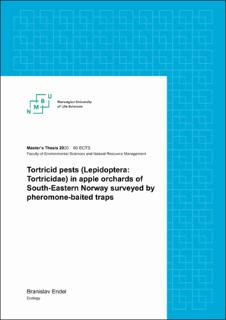| dc.description.abstract | The trend of minimizing pesticide usage in agriculture leads scientists to think about alternatives of how pest numbers can be reduced. The tortricid moths (Lepidoptera: Tortricidae) is a group of insects responsible for great damage in fruit orchards. Efficient models for predicting damage by these moths have so far mainly been developed for the most serious world-wide apple pest, the codling moth Cydia pomonella. Such forecasting models are not well-established for other tortricids and recent data on their status in Norwegian conditions are scare. The overall aim of this study was to provide such data on the flight activity of tortricids attacking apple trees, and thus contribute to the improvement of pest management in Norwegian orchards. The monitoring was undertaken in the Viken and Telemark regions, both in SouthEastern Norway, during 2018 and 2019. In each region, three orchards were selected. Six target species were surveyed by using pheromone-baited traps and some additional collecting of their immature stages. The presence of four out of the six target tortricids, C. pomonella, Pammene rhediella, Archips podana and Hedya nubiferana, was confirmed in high numbers. One species, Adoxophyes orana, was very rare in all the orchards and another, Pandemis heparana appeared to be rare, probably due to a poorly functioning pheromone attractant.
Differences in flight activity between the two years, one abnormally hot (2018) and the other slightly warmer than an average year (2019) were prominent. It was found that minimum temperature better explained the flight activity of 2 of the target species (spring and early summer ones), but in the case of A. podana (late summer species) the maximum temperature seemed to be a more important limiting factor. The majority (67%) of lepidopteran individuals caught by the pheromone traps belonged to the six target species. Regarding the remainder, 15% represented other pests and 18% were of species not considered as pests. Two pheromone lures, the ones employed for C. pomonella and P. rhediella, appeared to be reciprocal (attracting both target species). The lure for H.nubiferna trapped a greater amount of the non-target pest tortricid Grapholita funebrana than of the target. The lure for P. heparana surprisingly appeared to be more specific for the non-target pest tortricid Ptycholoma lecheana. Such a high proportion of non-target species caught in the target traps suggested that this issue needs to be taken into account. Their identification may be complicated for persons with little entomological experience. | en_US |

